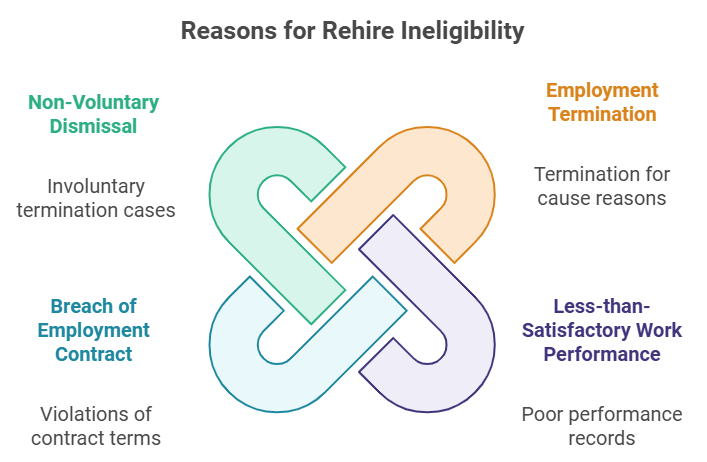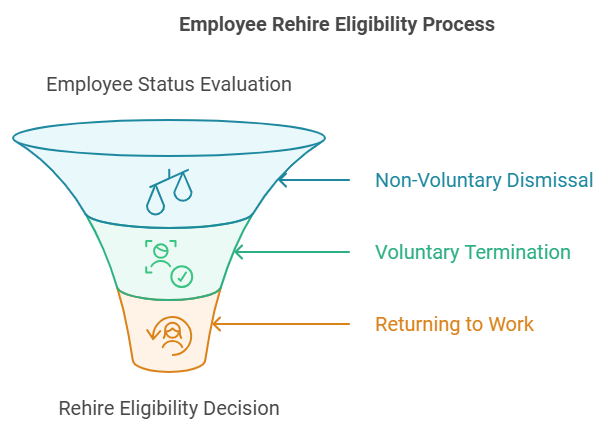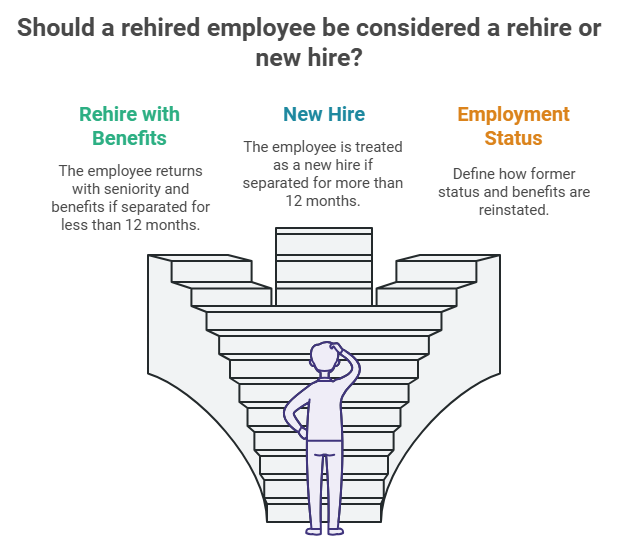
If you are hiring new talent for a position, you might also run into boomerang employees wanting to return to the company. There are both benefits and drawbacks to rehiring old employees and it is up to each company to form a policy on the rehire eligibility of former employees.
In this article, we will provide a guideline that can help your human resources department develop a such policy for a clear and concise hiring process.
Related articles:
How to Process Payroll for New Hires
Are Boomerang Employees Good For Your Business?
Why Should Not All Former Employees Be Considered for Rehire?
There are several benefits associated with rehiring former employees including higher retention rates, improved employee morale and labor relations. In some cases, the reinstated employees can also have a shorter onboarding timeline, saving both time and resources for the company.
However, not all former employees should be considered for rehire depending on the situation and the business functions of the company. For example, it would not be appropriate to consider rehiring in a circumstance where a former employee has broken an employment contract or employment law. Nevertheless, having a strict “no rehiring” policy can also be counterproductive as you can lose the opportunity of gaining back top talent.
Therefore, all human resource teams should have clear guidelines to follow during the recruitment process on what makes eligible employees for rehiring. This can be done by creating a rehiring policy that clearly outlines the rules regarding eligibility for re-employment that can be included in the employee handbook, policy manual, or in new hire information.
The rehire policy should also include what happens during the hiring and onboarding process for a boomerang employee.
Who Should Not Be Eligible for Rehire?
Several different reasons can lead up to why an employee is not granted rehire eligibility. Depending on your business functions and the structure of the company, the office of human resources should consider what will be the most appropriate for the business.
Employment Termination
If an employee has left the company due to termination for cause, they should not be rehired. This can include any job separation because of inappropriate behavior, harassment/discrimination, theft, or job abandonment. Any employee that was being terminated due to non-inclusive action is typically automatically ineligible for rehire.
Less-than-Satisfactory Work Performance
As all companies want to maintain certain performance standards, job performance can play a role in rehire eligibility. All employees who have a record at the company of less-than-satisfactory work performance should not be eligible for rehire. This could contain former employees with an unsatisfactory performance record, including a lower rating on their most recent performance evaluation or employees who terminated employment without any improvements on their performance plan.
Breach of Employment Contract
Employees who have previously broken employment contracts at the company should not be ineligible for rehire. This includes any type of breach of the contract of employment, such as leaking sensitive business information, sharing confidential employee information, and more. Typically, companies have a strict no-policy to a contractual breach, without considering if it happened on purpose or by accident.
Non-Voluntary Dismissal
In some cases, involuntary termination can be a reason to make an employee ineligible for rehire. Depending on the situation of your company, you may consider making involuntarily terminated employees ineligible for rehire. For example, if you fire an employee due to low employee standards or behavior that is not suited for the company, they should not be rehired.

Who Should Be Eligible for Rehire?
Once you have identified who will be ineligible for rehire, it is beneficial to establish who should be eligible for rehire. This will make it clearer for the recruiter during the hiring process. In all cases of rehiring, it is useful to access old employee information, including an old performance appraisal of the employee to learn about their job performance at the company before they left.
Non-Voluntary Dismissal
Although we mentioned that involuntary termination can be a cause for ineligibility for rehire, it can also be a cause for eligibility. It all depends on the situation which must be analyzed by the human resources team. For example, downsized or laid-off employees might be reinstated later when the financials are better, considering that the employee has a history of performing well in the company.
Voluntary Termination
Employees that have voluntarily left the company can be strong candidates for rehire, depending on what their status looked like when they left the job. Sometimes, employees leave the company for a new position at another firm, hoping that the grass is greener on the other side, only to learn that it is not. Rehiring a former employee that voluntarily left can be a valuable opportunity in gaining back top talent.
Returning to Work
Some employees might have chosen to resign due to personal or parental reasons, such as attending to the need of dependents or raising children. Depending on how long the unemployment time is and the track record of the employees, they might be entitled to rehire eligibility.

Policies to Adopt Before Rehiring an Employee
If your team decides to rehire an employee, certain policies and procedures should be in line to make it clear from the first day of employment for the reinstated employee. Employees that are returning after an involuntary termination might return fully reinstated with seniority and employee benefits.
In the policy for employees that have rehire eligibility, it should be defined at what time an employee is considered a rehire or considered a new hire.
For example, in many cases, an employee that has been separated from the company for more than 12 months will be considered a new hire. This means that the former employee will be treated the same as all other new hires during the hiring and onboarding process, including interviews, pre-employment assessments, employee orientation, and onboarding training.
However, if the employee has been separated from the company for less than 12 months, they can come back with a continuation of their old position.
The situation of reinstated employees might also depend on how long they worked for the company before their separations. This time period should also be defined in the policy. It can be appropriate to use a policy that compares the time away from the company with their time at the company. For example, if an employee has worked for the company for 3 years but has been away for 4 years, they might be reinstated as a new hire.
In the policy, it should also be defined if and how the returning employee will receive their former employment status and benefits. It can also be useful to include cases of special circumstances in the policy.

Conclusion
It is the responsibility of the human resources department to make it clear to recruiters and supervisors if former employees are entitled to rehire eligibility or not.
Reinstatement of an old employee can be beneficial for many reasons including, improved employee relations, higher retention rates, and a shorter onboarding timeline. In general, if the employees left on good terms and have a satisfactory record of job performance, they are granted rehire eligibility.
Employees are typically ineligible for rehire if the reason for terminating them in the first place includes non-disclose actions, lower performance standards, or a breach of the employment contract. In some cases, an involuntarily dismissed employee can also be eliminated from rehiring.
All HR teams should adopt policies and procedures that define the hiring and onboarding process in the case of reemployment. For example, employees that have had a long time off from the company should have the same recruitment process and onboarding as any other new employee, including the usual new hire orientation.

-360x360.jpg)
-1-640x380.jpg)

